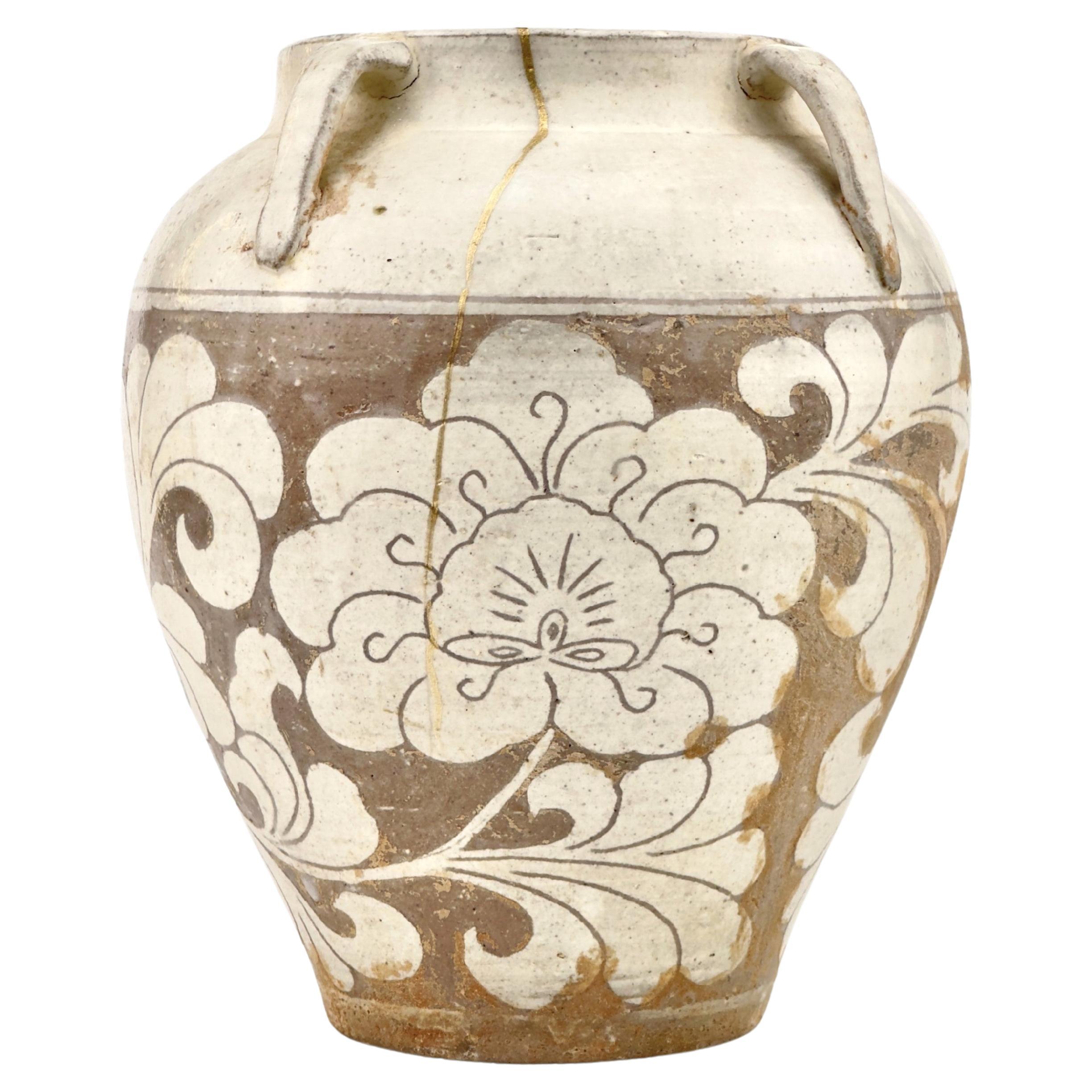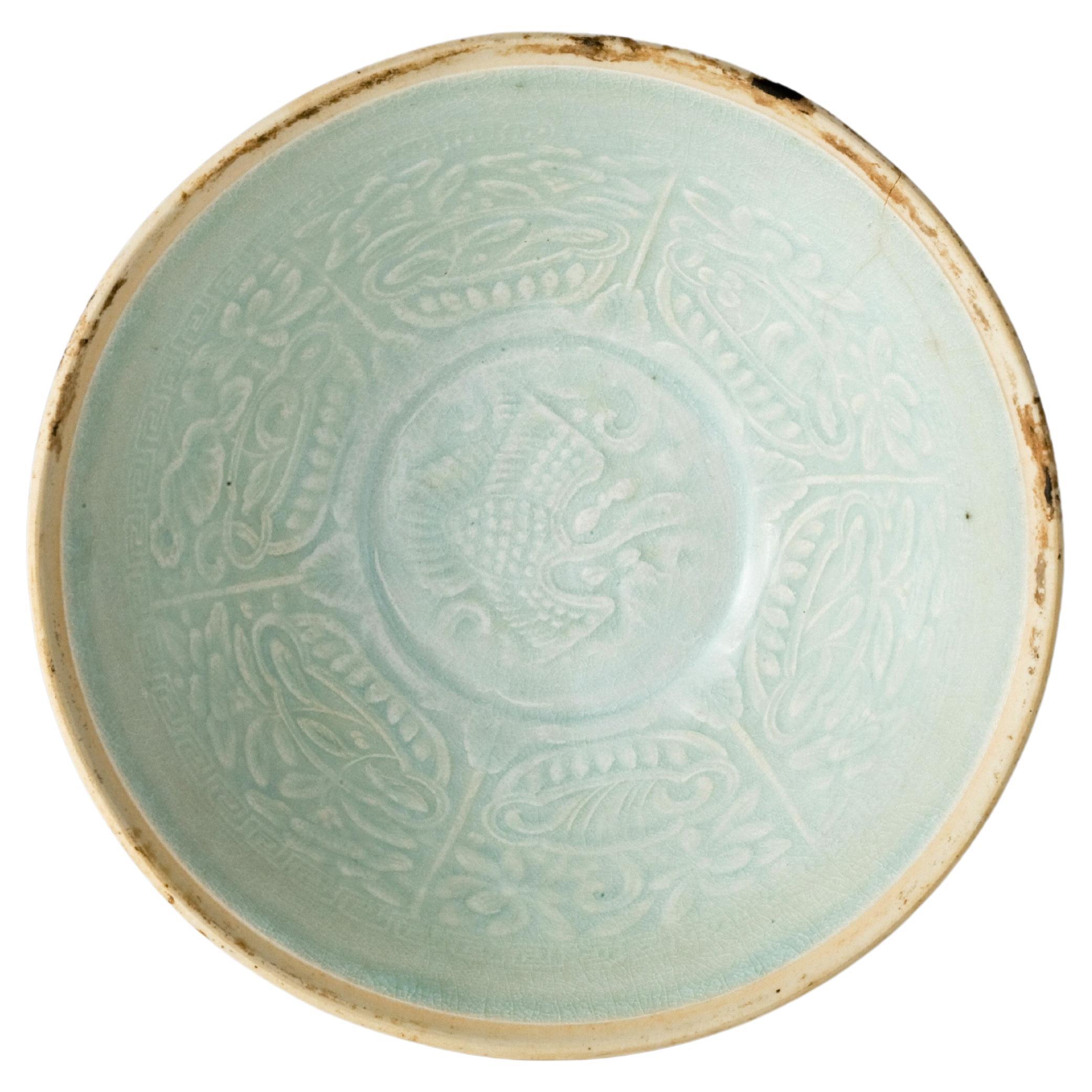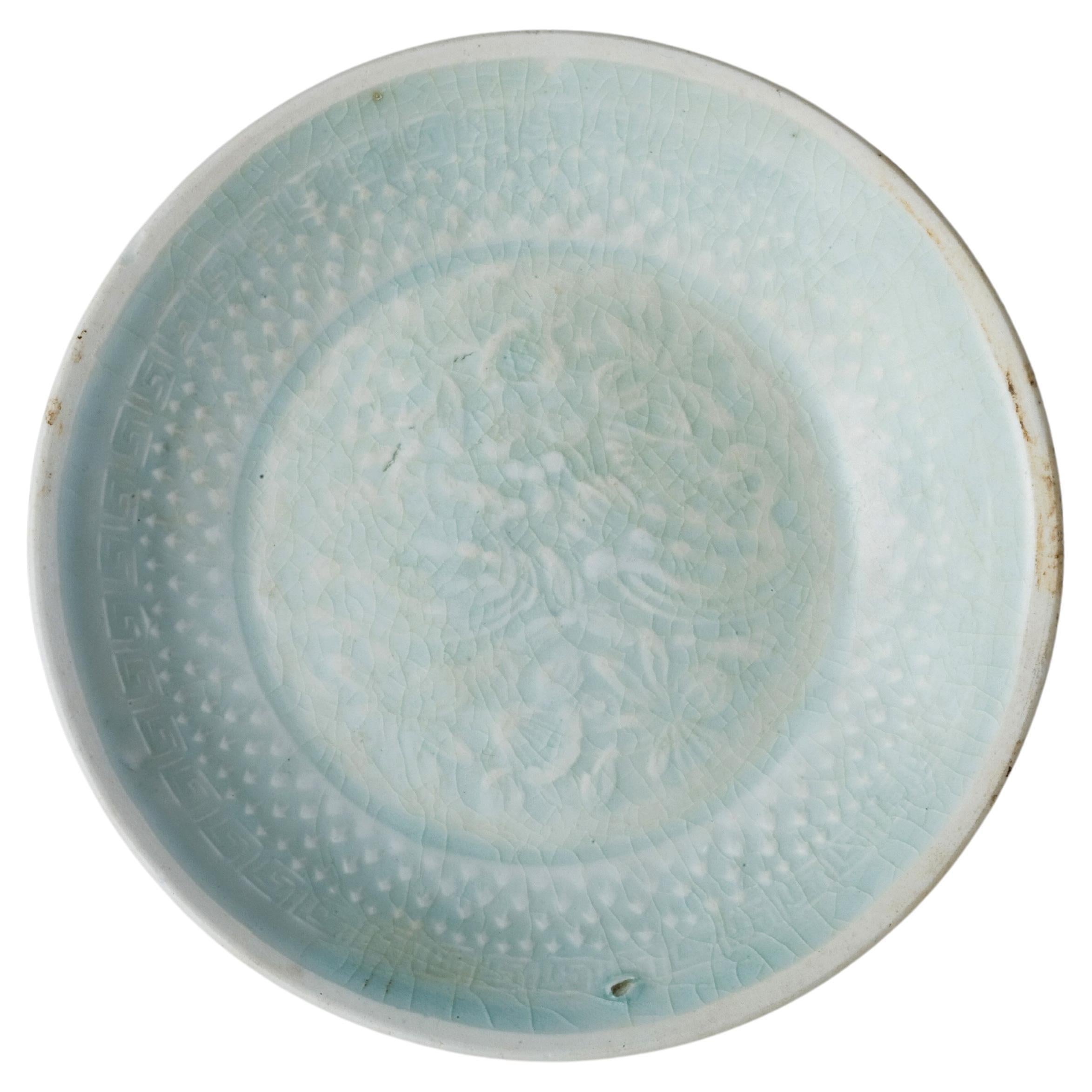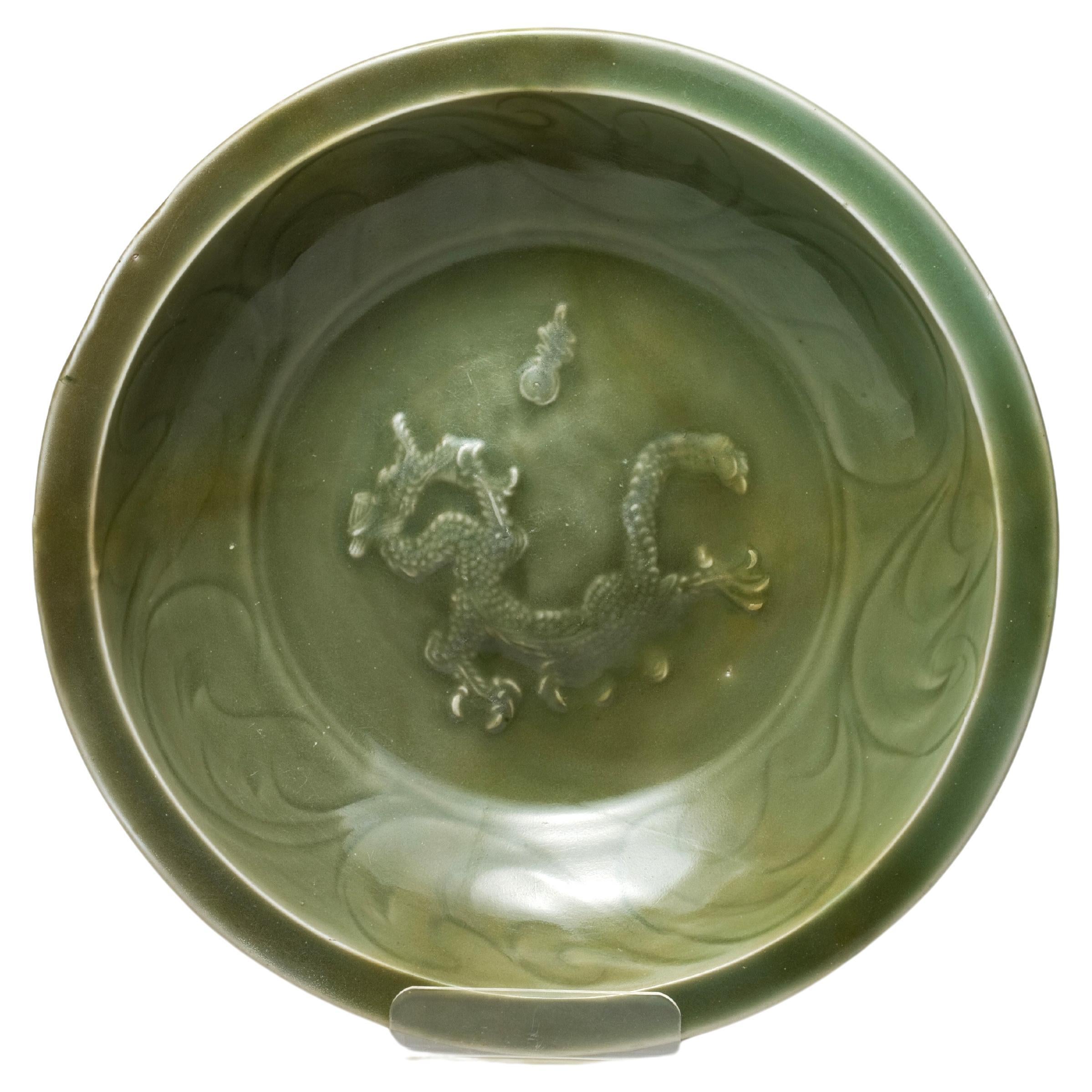Items Similar to Qingbai ewer with slip decoration of two phoenix and lotus leaves, Yuan Dynasty
Want more images or videos?
Request additional images or videos from the seller
1 of 7
Qingbai ewer with slip decoration of two phoenix and lotus leaves, Yuan Dynasty
About the Item
This small ewer is an exquisite example of Qingbai ware, known for its pale blue-tinged glaze. The vessel showcases the advanced ceramic techniques and artistic sophistication of the era. Its delicate form is enhanced by relief decorations depicting two phoenixes amidst lotus leaves, motifs rich in cultural and symbolic significance.
The body of the ewer tapers gently toward the base and is balanced by an elegantly curved spout and handle, the latter of which is finished with a slight twist typical of Yuan dynasty style. The relief decoration employs a technique that adds depth and texture to the surface, highlighting the craftsmanship of Yuan potters.
The phoenix, a mythical bird revered in Chinese tradition, symbolizes longevity and prosperity and is often associated with virtue and grace. The lotus leaves accompanying the phoenixes are emblematic of purity and enlightenment, echoing Buddhist teachings. The interplay of these symbols on the ewer suggests that it was more than a mere utilitarian object; it was imbued with cultural resonance and spiritual depth.
Period : Yuan Dynasty(1271-1368)
Type : Small Ewer
Medium : Qingbai Ware
Size : 9.0 cm(Height), 4cm(Diameter)
Provenance : Acquired in late 1990s, Hongkong
Reference : Art Gallery of NSW(Museum), Australia
Accession number 2311998
* Qingbai Ware
Qingbai ware, which translates to "blue-white ware," is a type of Chinese porcelain that was made at the Jingdezhen and other kilns in the porcelain-producing regions of China, primarily during the Song dynasty (960–1279) and continuing into the Yuan dynasty (1271–1368). It is known for its translucent quality and the pale blue-green glaze that characterizes most of its pieces.
The qingbai glaze was achieved using a small amount of iron in a reduction-fired atmosphere, which produced the subtle blue-green tint. The body of qingbai ware is typically made of a fine, white porcelain that is often referred to as 'artificial jade' due to its resemblance to the esteemed stone. The thinness of the body and the high firing temperatures used contributed to the translucent quality of the finished product.
Qingbai ware includes a range of items such as bowls, cups, vases, and ewers. The designs are usually simple and elegant, with an emphasis on the graceful lines and form of the objects. Decorative motifs, when present, are often incised, carved, or molded in relief and can include floral patterns, dragons, phoenixes, and other symbolic elements drawn from Chinese culture.
Over time, the technology and techniques used to produce qingbai ware evolved, leading to innovations in glaze and decoration that would influence later types of Chinese porcelain. Despite these changes, qingbai ware remains a distinguished example of the potters' art in Song and Yuan China, reflecting the refined aesthetic and cultural values of the period.
- Dimensions:Height: 3.55 in (9 cm)Diameter: 1.58 in (4 cm)
- Style:Ming (Of the Period)
- Materials and Techniques:
- Place of Origin:
- Period:
- Date of Manufacture:14th century
- Condition:Minor fading.
- Seller Location:seoul, KR
- Reference Number:1stDibs: LU9577238090742
About the Seller
New to 1stDibs
Joined in the past six months.
4.5
Vetted Seller
These experienced sellers undergo a comprehensive evaluation by our team of in-house experts.
Established in 1999
1stDibs seller since 2023
Typical response time: 1 hour
- ShippingRetrieving quote...Ships From: seoul, Korea South
- Return PolicyA return for this item may be initiated within 10 days of delivery.
More From This SellerView All
- Cizhou Rectangular Pillow with Carved Decoration, Yuan DynastyLocated in seoul, KRCizhou ware is known for its robust forms and freely applied decoration, often featuring a white slip under clear glaze. The pillow is rectangular, with a slightly curved top surface...Category
Antique 15th Century and Earlier Chinese Ming Antiquities
MaterialsPottery, Stoneware
- Cizhou Lotus Carved Jar, Song-Yuan dynastyLocated in seoul, KRThis jar features a carved design, which is typical of Cizhou ware. It has a creamy white and brown color scheme, and the prominent decoration of lotus flower, which is a common motif in Chinese art and culture, symbolizing purity and enlightenment. The carving technique involves coating the vessel with a layer of white slip (liquid clay), then carving away parts of it to create the design, revealing the darker clay body beneath. This technique allows for a strong contrast between the background and the carved motif. Period : Song-Yuan Dynasty Type : Jar Medium : Cizhou Ware Size : 21.5 cm(Height), 11cm(Mouth Diameter) Provenance : Acquired in 1999, Hongkong * Cizhou Ware Cizhou is the name given to a number of stonewares, grey or buff, of varying degrees of hardness, with painted, incised or carved decoration on a clay slip. These stonewares were not only made in the region of Cizhou, Hebei Province, but in several provinces of China during the Song, Yuan and Ming periods. The great centres of production were in the north of China in the provinces of Hebei, Henan and Shanxi. Cizhou wares seem to have been very popular, made for a clientèle of rich merchants, at a period when the paintings of famous...Category
Antique 15th Century and Earlier Chinese Ming Antiquities
MaterialsPottery
- Chinese Qingbai Small Model of a Granary Set, Song DynastyLocated in seoul, KRTwo granary model porcelains. East Asia, This pottery representation of a granary sits on a layered base, topped with a conical lid that also acts as its roof, all finished in a grey...Category
Antique 15th Century and Earlier Chinese Ming Antiquities
MaterialsCeramic, Porcelain
- Qingbai Bowl with carving of crane, Song DynastyLocated in seoul, KRThe crane, a traditional symbol of longevity and auspiciousness, is prominently placed at the center, creating a harmonious and aesthetically balanced effect. The border of the dish ...Category
Antique 15th Century and Earlier Chinese Chinese Export Antiquities
MaterialsPorcelain
- A Molded Qingbai 'Flowers' Dish, Southern Song DynastyLocated in seoul, KRThe plate depicted here exhibits the intricate floral patterns and lotus motifs that are typical of Southern Song designs. The central floral motif captures the essence of Oriental b...Category
Antique 15th Century and Earlier Chinese Ming Antiquities
MaterialsCeramic
- A Longquan Celadon-Glazed 'Dragon' Dish, Yuan DynastyLocated in seoul, KRThe dish is decorated to the centre with a moulded appliqué dragon chasing the flaming pearl surrounded by a carved stylised foliage band at the cavetto. The moulded fluted exterior ...Category
Antique 15th Century and Earlier Chinese Ming Antiquities
MaterialsCeladon
You May Also Like
- Yuan Dynasty, A Set of Rare Antique Chinese Pottery AnimalsLocated in Sampantawong, THA set of rare Chinese pottery animals. Age: China, Yuan Dynasty, A.D. 1271 - 1368 Size: Length 10.4 - 15.3 C.M. / Width 6 - 8.8 C.M. / Height 6.5 - 10.8 C.M. Condition: Well-pre...Category
Antique 15th Century and Earlier Chinese Antiquities
MaterialsPottery
- Yuan Dynasty, Antique Chinese Brown Glazed Pottery JarLocated in Sampantawong, THChinese brown glazed pottery jar with round shape. Age: China, Yuan Dynasty, 13th Century Size: height 21.8 cm / width 27.5 cm Condition: Well-preser...Category
Antique 15th Century and Earlier Chinese Antiquities
MaterialsPottery
- Yuan Dynasty, Antique Chinese Green Glazed Pottery Covered JarLocated in Sampantawong, THChinese green glazed pottery covered jar. Age: China, Yuan Dynasty, A.D. 1271 - 1368 Size: height 35 cm / width 25 cm. Condition: Wel...Category
Antique 15th Century and Earlier Chinese Antiquities
MaterialsPottery
- Yuan Dynasty, Antique Chinese Green Glazed Pottery Covered JarLocated in Sampantawong, THChinese green glazed pottery covered jar. Age: China, Yuan Dynasty, A.D. 1271 - 1368 Size: Height 35.7 C.M. / Width 27 C.M. Condition: We...Category
Antique 15th Century and Earlier Chinese Antiquities
MaterialsPottery
- Large pair of Japanese ‘Jyôka’ 常花, sets of gilded lotus flowers and -leaves.Located in Amsterdam, NLA spectacular pair of black glass vases each adorned with 13 large handmade gilded wooden lotus flowers and -leaves with refined details. Such a set is known as ‘Jyôka’, and are typically positioned on or beside an altar in a Buddhist temple. The lotus flowers are at different stages of their life (unfurled lotus leaves, buds and blooms) and symbolize the journey towards Buddhist enlightenment. What sets this pair apart is its size; it is considerably larger than many similar sets, making it a rare find. As well as that it has such an extensive array of gilded flowers. The flowers, which are detachable, allow for customizable arrangements within the vases. Period: Japan – lotuses...Category
Antique Late 19th Century Japanese Antiquities
MaterialsGlass, Giltwood, Lacquer
- Fine Cloisonne Lidded Box, Japan, Meiji Era, with Phoenix DecorationLocated in Hamburg, DEFine Japanese cloisonne lidded box from the Meiji period. The small box stands on three brass feet. The lid, also made of brass, has a small flowe...Category
Early 20th Century Japanese Meiji Antiquities
MaterialsBrass, Enamel
Recently Viewed
View AllMore Ways To Browse
Carved Green Jade Vase
China Ware Asian Antiquities Blue And White
High Relief Ewers
Chinese Molded Glazed Dragon Vase
Yuan Blue And White
China Ware Asian Antiquities Blue And White
Chinese Stirrups
Peranakan Silver Salver
Ceramic Monkey Statue
Metal Bronze Table
French Painted Lighting
European Arts And Crafts
Wool Rug Diamond Pattern
Navy Persian Rug Hand Knotted
Ideal Luxury
In Stock Seating
Side Table Writing Table
Powder Room Chair





